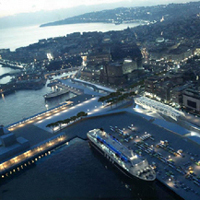The Waterfront project in Naples
Abstract
In the last decade Naples the port of Naples has rediscovered its wide-ranging role not merely concerned with the sea but also with the adjacent city. A strong connection has now returned between Naples and its port: the elimination of the barriers around the port and the pedestrianisation of the tourist area will help to link the city with its port and, as a consequence, with the sea. The rationalisation and specialisation plans of the port area mean that the port will become an increasingly dynamic force working in harmony with the city and its hinterland. Now no longer an obstacle, the port of Naples has a wide range of activities (commercial, productive, tourism and cultural) which all use the sea as a point of exchange, transformation and growth. One of the principal project of the reconnection of the port of Naples and the surrounding city is the Waterfront Project. The Waterfront project take part of a bigger renewal process that the city of Naples and the Port authority of Naples are working on, that and which is going to focus on the following issues: - Taking the cruise traffic to develop new attractive/ aggregative poles for cruise tourists and inhabitants on the waterfront in deprived areas. - Conjugating the safety theme with the permeability of the port by the inhabitants and the tourists and toning down the physical obstacles. - Rationalizing the organization of the port and improving the passenger port area. - Encouraging a better utilization of the historical and monumental heritage of the city and of the abandoned former industrial areas of the port and of the city-port interface. - Improving the governance of the projects of urban / port transformation for a real coordination between the different stakeholders involved in a shared management of the projects and of the objectives. In this context, the Waterfront project aims at: - improving the connection between port and city which will create a high quality tourist support for cruise passengers; - strengthening and rationalization of the logistic-port infrastructures, taking in account the multifunctional vocation of the port. - creating a positive economic impact for commercial and handicraft industrial areas close to the port - the re-qualification of the building heritage close to the port area with a subsequent increase and enhancement of the hosting infrastructures. - strengthening sustainable mobility will decrease the high level of atmospheric and acoustic pollution. - approaching the cruise activity is an opportunity to redevelop the industrial derelict areas in urban park and recreational/cultural places and to upgrade the quality of life.Downloads

Copyright (c) 2014 Tema. Journal of Land Use, Mobility and Environment

This work is licensed under a Creative Commons Attribution 4.0 International License.
Authors who publish in this journal agree to the following:
1. Authors retain the rights to their work and give in to the journal the right of first publication of the work simultaneously licensed under a Creative Commons License - Attribution that allows others to share the work indicating the authorship and the initial publication in this journal.
2. Authors can adhere to other agreements of non-exclusive license for the distribution of the published version of the work (ex. To deposit it in an institutional repository or to publish it in a monography), provided to indicate that the document was first published in this journal.
3. Authors can distribute their work online (ex. In institutional repositories or in their website) prior to and during the submission process, as it can lead to productive exchanges and it can increase the quotations of the published work (See The Effect of Open Access)
